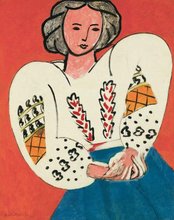Exhibition
Matisse
Like a novel
21 Oct 2020 - 22 Feb 2021
21 Oct 2020 - 22 Feb 2021

The event is over

Henri Matisse, « La Blouse roumaine », 1940. Centre Pompidou, Musée national d’art moderne. Don de l’artiste à l’État, 1953 © Succession H. Matisse Photo © Centre Pompidou, Mnam-Cci / G. Meguerditchian / Dist. RMN-GP
On the occasion of the hundred-and-fiftieth anniversary of the birth of Henri Matisse (1869 - 1954), the Centre Pompidou pays homage to him with the exhibition "Matisse, comme un roman" [Like a novel], with more than two hundred and thirty works and seventy documents and archives. "The importance of an artist is measured by the quantity of new signs he introduces to the plastic language", Matisse remarked. He was a decisive innovator throughout his life. A chronological tour in nine chapters traces the beginnings of the young artist, who came late to painting in the 1890s, to the complete liberation of line and colour with the cut-up gouaches he made in the twilight of his days.

Henri Matisse, « La Blouse roumaine », 1940. Centre Pompidou, Musée national d’art moderne. Don de l’artiste à l’État, 1953 © Succession H. Matisse Photo © Centre Pompidou, Mnam-Cci / G. Meguerditchian / Dist. RMN-GP
The exhibition presents for the first time one hundred works from the collection of the Musée National d'Art Moderne, one of the most significant in terms of size, representing all the techniques that Matisse never tired of developing in depth. For this event, the collection is enriched with remarkable loans granted by French museums: the two Matisse museums in France, and the rich Matisse collection of the Grenoble museum, from which L’Intérieur aux aubergines [Interior with Aubergines] (1911) is on special loan. This gathering of key-works from major French and international collections illustrates Matisse's trajectory over more than five decades, and some of the most important pages in modern art.
Borrowing from the title of Louis Aragon's work, Henri Matisse, roman [Matisse, a novel] (1971), the exhibition applies his principle of advancing through the work. Each of the nine sequences in the exhibition is illuminated by an author's vision of Matisse's work: Louis Aragon, Georges Duthuit, Dominique Fourcade, Clement Greenberg, Charles Lewis Hind, Pierre Schneider, Jean Clay and Henri Matisse himself. Echoing these writers, critics and poets, the exhibition questions Matisse's relationship with all forms of writing – from the plastic sign to words.
"Where do we mark this beginning?" Aragon asks. From the very beginning, Matisse tried out different practices. This painter, sculptor, draughtsman, engraver, sought to find "a way of writing for each object". As an artist with very high critical standards, he deliberately sought throughout his life to shed light on his creative process, giving birth in spite of himself to Matisse the writer. Thus, "Matisse explique Matisse" [Matisse explains Matisse]: "a Fauvist painting is a luminous bloc formed by the harmony of several colour, forming a possible space for the mind". During the Fauvist period (1905 - 1906), he launched himself into a radical reformulation of colour and drawing.
This revolution in terms of vision was reconfigured in the 1910s around a consideration of decorative art, one of the most masterly examples being L’Intérieur aux aubergines [Interior with Aubergines] (1911), the only one of the symphonic interiors to be preserved in France. However, this new plastic expression was not fixed in a style: the painter sought to test the various trends running through the artistic scene of his day – Cubism, particularly, with Tête blanche et rose [White and Pink Head] (1914). In 1917, his departure for Nice and the following decade abandoned the experimental dimension of an art that had almost reached the threshold of abstraction: the painter chose to return to a subject modelled by light.
The literary dimension of Matisse's work took a new turn from the 1930s onward, when he focussed on illustrated books with Mallarmé's Poems, which resonated with some iconic canvases like Nymphe dans la forêt [Nymph in the Forest] (La Verdure) (1935 - 1943). With Jazz in 1947, Matisse succeeded in interlacing the plastic with the word, creating cut-up gouaches and manuscript texts. We find the expansive character of colour and black and white in the intimate dialogue between the Vence Interiors and brush drawings. Lastly, the colourful stained glass and ceramics of the chapel at Vence still testify to an uninterrupted migration of the work toward writing in what Matisse saw as an open book in space.
Where
Gallery 1, level 6
When
21 Oct 2020 - 22 Feb 2021
10am - 8pm, every days except tuesdaysCurrently closed
Partners
L'exposition bénéficie du soutien de


Grand mécène Grand mécène

L'exposition est organisée avec le soutien exceptionnel des musées :
Musée de Grenoble
Musée départemental Matisse du Cateau-Cambrésis
Musée Matisse de Nice
Musée national Picasso-Paris

En partenariat média avec
![]()
![]()
![]()



In the magazine
In the shop
































